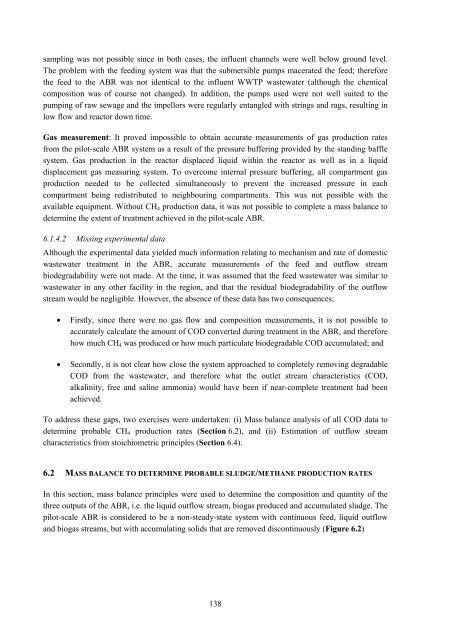analysis of a pilot-scale anaerobic baffled reactor treating domestic ...
analysis of a pilot-scale anaerobic baffled reactor treating domestic ...
analysis of a pilot-scale anaerobic baffled reactor treating domestic ...
You also want an ePaper? Increase the reach of your titles
YUMPU automatically turns print PDFs into web optimized ePapers that Google loves.
sampling was not possible since in both cases, the influent channels were well below ground level.<br />
The problem with the feeding system was that the submersible pumps macerated the feed; therefore<br />
the feed to the ABR was not identical to the influent WWTP wastewater (although the chemical<br />
composition was <strong>of</strong> course not changed). In addition, the pumps used were not well suited to the<br />
pumping <strong>of</strong> raw sewage and the impellors were regularly entangled with strings and rags, resulting in<br />
low flow and <strong>reactor</strong> down time.<br />
Gas measurement: It proved impossible to obtain accurate measurements <strong>of</strong> gas production rates<br />
from the <strong>pilot</strong>-<strong>scale</strong> ABR system as a result <strong>of</strong> the pressure buffering provided by the standing baffle<br />
system. Gas production in the <strong>reactor</strong> displaced liquid within the <strong>reactor</strong> as well as in a liquid<br />
displacement gas measuring system. To overcome internal pressure buffering, all compartment gas<br />
production needed to be collected simultaneously to prevent the increased pressure in each<br />
compartment being redistributed to neighbouring compartments. This was not possible with the<br />
available equipment. Without CH4 production data, it was not possible to complete a mass balance to<br />
determine the extent <strong>of</strong> treatment achieved in the <strong>pilot</strong>-<strong>scale</strong> ABR.<br />
6.1.4.2 Missing experimental data<br />
Although the experimental data yielded much information relating to mechanism and rate <strong>of</strong> <strong>domestic</strong><br />
wastewater treatment in the ABR, accurate measurements <strong>of</strong> the feed and outflow stream<br />
biodegradability were not made. At the time, it was assumed that the feed wastewater was similar to<br />
wastewater in any other facility in the region, and that the residual biodegradability <strong>of</strong> the outflow<br />
stream would be negligible. However, the absence <strong>of</strong> these data has two consequences;<br />
• Firstly, since there were no gas flow and composition measurements, it is not possible to<br />
accurately calculate the amount <strong>of</strong> COD converted during treatment in the ABR, and therefore<br />
how much CH4 was produced or how much particulate biodegradable COD accumulated; and<br />
• Secondly, it is not clear how close the system approached to completely removing degradable<br />
COD from the wastewater, and therefore what the outlet stream characteristics (COD,<br />
alkalinity, free and saline ammonia) would have been if near-complete treatment had been<br />
achieved.<br />
To address these gaps, two exercises were undertaken: (i) Mass balance <strong>analysis</strong> <strong>of</strong> all COD data to<br />
determine probable CH4 production rates (Section 6.2), and (ii) Estimation <strong>of</strong> outflow stream<br />
characteristics from stoichiometric principles (Section 6.4).<br />
6.2 MASS BALANCE TO DETERMINE PROBABLE SLUDGE/METHANE PRODUCTION RATES<br />
In this section, mass balance principles were used to determine the composition and quantity <strong>of</strong> the<br />
three outputs <strong>of</strong> the ABR, i.e. the liquid outflow stream, biogas produced and accumulated sludge. The<br />
<strong>pilot</strong>-<strong>scale</strong> ABR is considered to be a non-steady-state system with continuous feed, liquid outflow<br />
and biogas streams, but with accumulating solids that are removed discontinuously (Figure 6.2)<br />
138
















